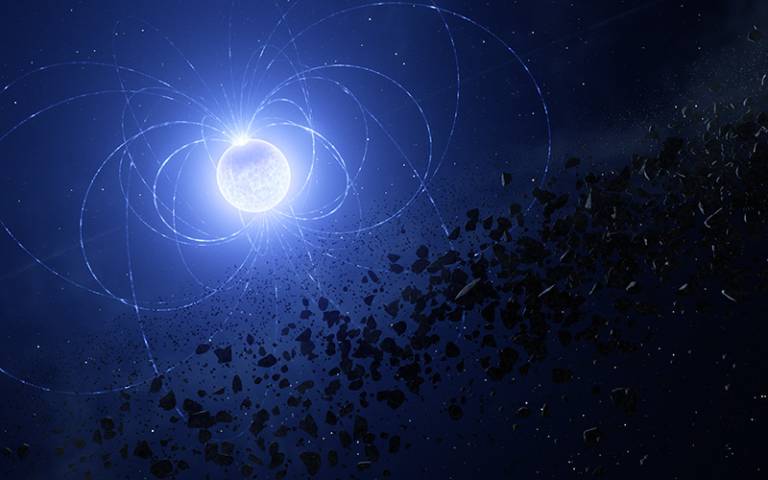The unique signature of a star ingesting its surrounding planets and asteroids - a metal scar imprinted on the surface of a white dwarf star - has been found for the first time by a team including UCL researchers.

White dwarfs are glowing embers of stars that have burned through all their hydrogen fuel. Nearly all stars, including the Sun, will eventually become white dwarfs.
For the new study, published in The Astrophysical Journal Letters, the research team used the European Southern Observatory's Very Large Telescope (ESO's VLT) in Chile to observe a concentration of metals imprinted on the surface of the white dwarf WD 0816-310, an Earth-sized remnant of a star somewhat more massive than the Sun.
They concluded that the star's magnetic field funnelled metals on to its surface, creating the scar, a feature never seen before on a white dwarf star.
Lead author Dr Stefano Bagnulo (Honorary, Mullard Space Science Laboratory at UCL, and Armagh Observatory and Planetarium in Northern Ireland), said: "It is well known that some white dwarfs are cannibalising pieces of their planetary systems. Now we have discovered that the star's magnetic field plays a key role in this process, resulting in a scar on the white dwarf's surface."
Co-author Professor Jay Farihi (UCL Physics & Astronomy): "Our analysis demonstrates that this metal scar has been present on the star for much longer than predicted by any theory, and that the material is highly Earth-like in its composition. Altogether, we can deduce that the metals originate from a planetary fragment as large as or possibly larger than Vesta; around 500 kilometres across, it is the second-largest asteroid in the Solar System, and often referred to as a planetary embryo or proto-planet."
The observations provided clues to how the star got its metal scar. The team noticed that the strength of the metal detection changed as the star rotated, suggesting that the metals were concentrated on a specific area on the white dwarf's surface, rather than smoothly spread across it. They also found that these changes were synchronised with changes in the white dwarf's magnetic field, indicating that this metal scar was located on one of its magnetic poles. Together, these clues indicated that the magnetic field funnelled metals on to the star.
Previously, astronomers have observed numerous white dwarfs polluted by metals that were scattered across the surface of the star. These are known to originate from disrupted planets or asteroids that veer too close to the star, following star-grazing orbits similar to those of comets in our Solar System.
YouTube Widget Placeholderhttps://www.youtube.com/watch?v=uQm-Q2FwQtw
Co-author Professor John Landstreet, of the University of Western Ontario, Canada, and the Armagh Observatory and Planetarium, said: "Surprisingly, the material was not evenly mixed over the surface of the star, as predicted by theory. Instead, this scar is a concentrated patch of planetary material, held in place by the same magnetic field that has guided the in-falling fragments. Nothing like this has been seen before."
To reach these conclusions, the team used a 'Swiss-army knife' instrument on the VLT called FORS2, which allowed them to detect the metal scar and connect it to the star's magnetic field.
Dr Bagnulo said: "ESO has the unique combination of capabilities needed to observe faint objects such as white dwarfs, and sensitively measure stellar magnetic fields."
In their study, the team also relied on archival data from the VLT's X-shooter instrument to confirm their findings.
Harnessing the power of observations like these, astronomers can reveal the bulk composition of exoplanets, planets orbiting other stars outside the Solar System. This unique study also shows how planetary systems can remain dynamically active, even after 'death'.






